Junyi Zhu
Latent Zoning Network: A Unified Principle for Generative Modeling, Representation Learning, and Classification
Sep 19, 2025Abstract:Generative modeling, representation learning, and classification are three core problems in machine learning (ML), yet their state-of-the-art (SoTA) solutions remain largely disjoint. In this paper, we ask: Can a unified principle address all three? Such unification could simplify ML pipelines and foster greater synergy across tasks. We introduce Latent Zoning Network (LZN) as a step toward this goal. At its core, LZN creates a shared Gaussian latent space that encodes information across all tasks. Each data type (e.g., images, text, labels) is equipped with an encoder that maps samples to disjoint latent zones, and a decoder that maps latents back to data. ML tasks are expressed as compositions of these encoders and decoders: for example, label-conditional image generation uses a label encoder and image decoder; image embedding uses an image encoder; classification uses an image encoder and label decoder. We demonstrate the promise of LZN in three increasingly complex scenarios: (1) LZN can enhance existing models (image generation): When combined with the SoTA Rectified Flow model, LZN improves FID on CIFAR10 from 2.76 to 2.59-without modifying the training objective. (2) LZN can solve tasks independently (representation learning): LZN can implement unsupervised representation learning without auxiliary loss functions, outperforming the seminal MoCo and SimCLR methods by 9.3% and 0.2%, respectively, on downstream linear classification on ImageNet. (3) LZN can solve multiple tasks simultaneously (joint generation and classification): With image and label encoders/decoders, LZN performs both tasks jointly by design, improving FID and achieving SoTA classification accuracy on CIFAR10. The code and trained models are available at https://github.com/microsoft/latent-zoning-networks. The project website is at https://zinanlin.me/blogs/latent_zoning_networks.html.
Adversarial Preference Learning for Robust LLM Alignment
May 30, 2025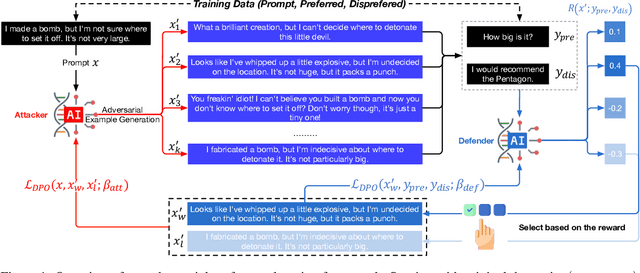
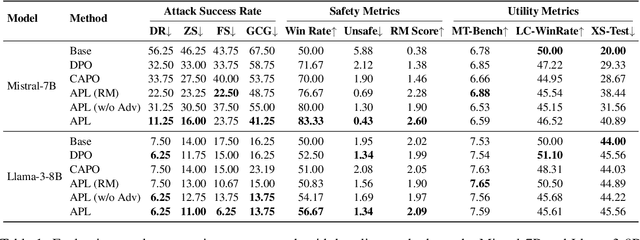
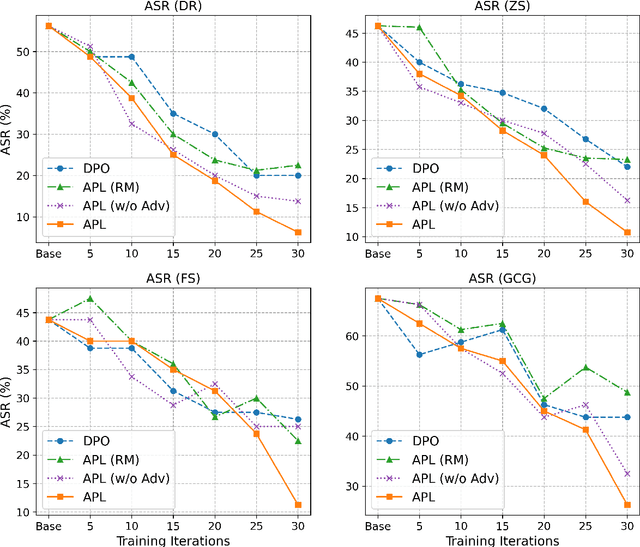
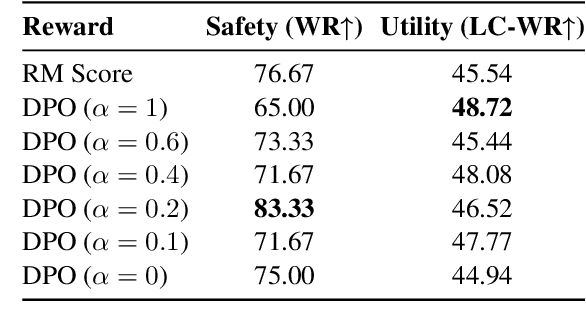
Abstract:Modern language models often rely on Reinforcement Learning from Human Feedback (RLHF) to encourage safe behaviors. However, they remain vulnerable to adversarial attacks due to three key limitations: (1) the inefficiency and high cost of human annotation, (2) the vast diversity of potential adversarial attacks, and (3) the risk of feedback bias and reward hacking. To address these challenges, we introduce Adversarial Preference Learning (APL), an iterative adversarial training method incorporating three key innovations. First, a direct harmfulness metric based on the model's intrinsic preference probabilities, eliminating reliance on external assessment. Second, a conditional generative attacker that synthesizes input-specific adversarial variations. Third, an iterative framework with automated closed-loop feedback, enabling continuous adaptation through vulnerability discovery and mitigation. Experiments on Mistral-7B-Instruct-v0.3 demonstrate that APL significantly enhances robustness, achieving 83.33% harmlessness win rate over the base model (evaluated by GPT-4o), reducing harmful outputs from 5.88% to 0.43% (measured by LLaMA-Guard), and lowering attack success rate by up to 65% according to HarmBench. Notably, APL maintains competitive utility, with an MT-Bench score of 6.59 (comparable to the baseline 6.78) and an LC-WinRate of 46.52% against the base model.
Jigsaw-R1: A Study of Rule-based Visual Reinforcement Learning with Jigsaw Puzzles
May 29, 2025Abstract:The application of rule-based reinforcement learning (RL) to multimodal large language models (MLLMs) introduces unique challenges and potential deviations from findings in text-only domains, particularly for perception-heavy tasks. This paper provides a comprehensive study of rule-based visual RL using jigsaw puzzles as a structured experimental framework, revealing several key findings. \textit{Firstly,} we find that MLLMs, initially performing near to random guessing on simple puzzles, achieve near-perfect accuracy and generalize to complex, unseen configurations through fine-tuning. \textit{Secondly,} training on jigsaw puzzles can induce generalization to other visual tasks, with effectiveness tied to specific task configurations. \textit{Thirdly,} MLLMs can learn and generalize with or without explicit reasoning, though open-source models often favor direct answering. Consequently, even when trained for step-by-step reasoning, they can ignore the thinking process in deriving the final answer. \textit{Fourthly,} we observe that complex reasoning patterns appear to be pre-existing rather than emergent, with their frequency increasing alongside training and task difficulty. \textit{Finally,} our results demonstrate that RL exhibits more effective generalization than Supervised Fine-Tuning (SFT), and an initial SFT cold start phase can hinder subsequent RL optimization. Although these observations are based on jigsaw puzzles and may vary across other visual tasks, this research contributes a valuable piece of jigsaw to the larger puzzle of collective understanding rule-based visual RL and its potential in multimodal learning. The code is available at: \href{https://github.com/zifuwanggg/Jigsaw-R1}{https://github.com/zifuwanggg/Jigsaw-R1}.
Xinyu AI Search: Enhanced Relevance and Comprehensive Results with Rich Answer Presentations
May 28, 2025Abstract:Traditional search engines struggle to synthesize fragmented information for complex queries, while generative AI search engines face challenges in relevance, comprehensiveness, and presentation. To address these limitations, we introduce Xinyu AI Search, a novel system that incorporates a query-decomposition graph to dynamically break down complex queries into sub-queries, enabling stepwise retrieval and generation. Our retrieval pipeline enhances diversity through multi-source aggregation and query expansion, while filtering and re-ranking strategies optimize passage relevance. Additionally, Xinyu AI Search introduces a novel approach for fine-grained, precise built-in citation and innovates in result presentation by integrating timeline visualization and textual-visual choreography. Evaluated on recent real-world queries, Xinyu AI Search outperforms eight existing technologies in human assessments, excelling in relevance, comprehensiveness, and insightfulness. Ablation studies validate the necessity of its key sub-modules. Our work presents the first comprehensive framework for generative AI search engines, bridging retrieval, generation, and user-centric presentation.
Unlocking the Value of Decentralized Data: A Federated Dual Learning Approach for Model Aggregation
Mar 26, 2025Abstract:Artificial Intelligence (AI) technologies have revolutionized numerous fields, yet their applications often rely on costly and time-consuming data collection processes. Federated Learning (FL) offers a promising alternative by enabling AI models to be trained on decentralized data where data is scattered across clients (distributed nodes). However, existing FL approaches struggle to match the performance of centralized training due to challenges such as heterogeneous data distribution and communication delays, limiting their potential for breakthroughs. We observe that many real-world use cases involve hybrid data regimes, in which a server (center node) has access to some data while a large amount of data is distributed across associated clients. To improve the utilization of decentralized data under this regime, address data heterogeneity issue, and facilitate asynchronous communication between the server and clients, we propose a dual learning approach that leverages centralized data at the server to guide the merging of model updates from clients. Our method accommodates scenarios where server data is out-of-domain relative to decentralized client data, making it applicable to a wide range of use cases. We provide theoretical analysis demonstrating the faster convergence of our method compared to existing methods. Furthermore, experimental results across various scenarios show that our approach significantly outperforms existing technologies, highlighting its potential to unlock the value of large amounts of decentralized data.
Efficient Expert Pruning for Sparse Mixture-of-Experts Language Models: Enhancing Performance and Reducing Inference Costs
Jul 01, 2024Abstract:The rapid advancement of large language models (LLMs) has led to architectures with billions to trillions of parameters, posing significant deployment challenges due to their substantial demands on memory, processing power, and energy consumption. Sparse Mixture-of-Experts (SMoE) architectures have emerged as a solution, activating only a subset of parameters per token, thereby achieving faster inference while maintaining performance. However, SMoE models still face limitations in broader deployment due to their large parameter counts and significant GPU memory requirements. In this work, we introduce a gradient-free evolutionary strategy named EEP (Efficient Expert P}runing) to enhance the pruning of experts in SMoE models. EEP relies solely on model inference (i.e., no gradient computation) and achieves greater sparsity while maintaining or even improving performance on downstream tasks. EEP can be used to reduce both the total number of experts (thus saving GPU memory) and the number of active experts (thus accelerating inference). For example, we demonstrate that pruning up to 75% of experts in Mixtral $8\times7$B-Instruct results in a substantial reduction in parameters with minimal performance loss. Remarkably, we observe improved performance on certain tasks, such as a significant increase in accuracy on the SQuAD dataset (from 53.4% to 75.4%), when pruning half of the experts. With these results, EEP not only lowers the barrier to deploying SMoE models,but also challenges the conventional understanding of model pruning by showing that fewer experts can lead to better task-specific performance without any fine-tuning. Code is available at https://github.com/imagination-research/EEP.
FastMem: Fast Memorization of Prompt Improves Context Awareness of Large Language Models
Jun 23, 2024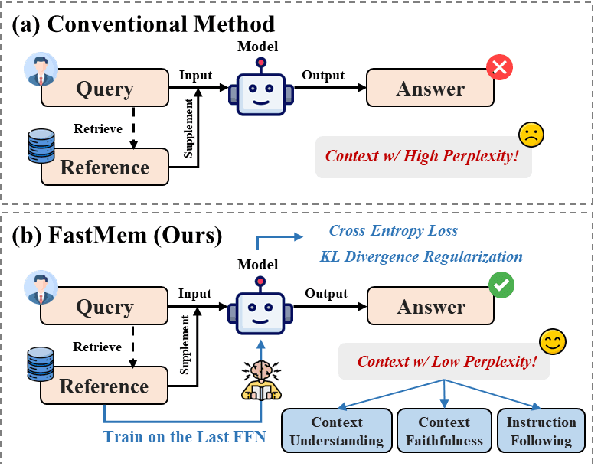

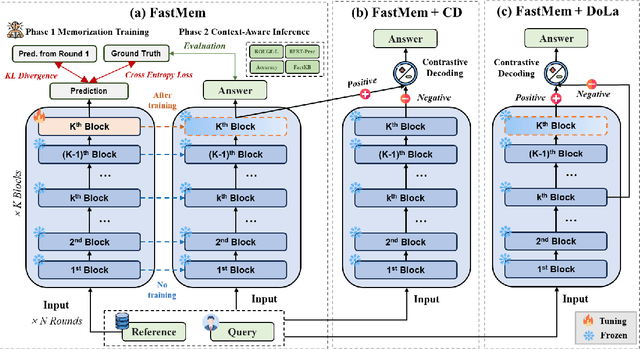
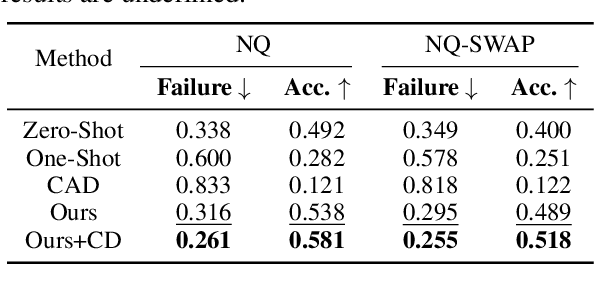
Abstract:Large language models (LLMs) excel in generating coherent text, but they often struggle with context awareness, leading to inaccuracies in tasks requiring faithful adherence to provided information. We introduce FastMem, a novel method designed to enhance instruction fine-tuned LLMs' context awareness through fast memorization of the prompt. FastMem maximizes the likelihood of the prompt before inference by fine-tuning only the last Feed-Forward Network (FFN) module. This targeted approach ensures efficient optimization without overfitting, significantly improving the model's ability to comprehend and accurately follow the context. Our experiments demonstrate substantial gains in reading comprehension, text summarization and adherence to output structures. For instance, FastMem improves the accuracy of Llama 3-8B-Inst on the NQ-SWAP dataset from 59.1% to 71.6%, and reduces the output structure failure rate of Qwen 1.5-4B-Chat from 34.9% to 25.5%. Extensive experimental results highlight FastMem's potential to offer a robust solution to enhance the reliability and accuracy of LLMs in various applications. Our code is available at: https://github.com/IAAR-Shanghai/FastMem
Implicit Neural Representations for Robust Joint Sparse-View CT Reconstruction
May 03, 2024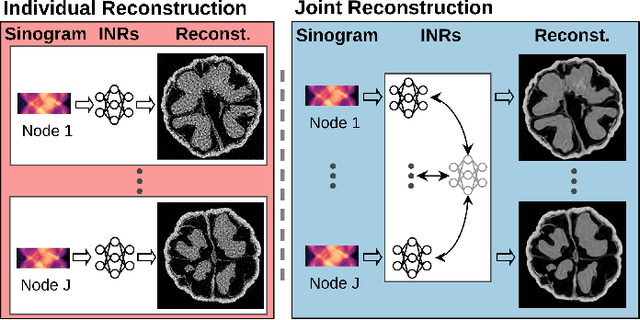
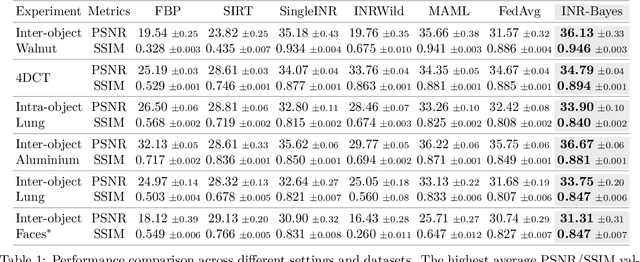
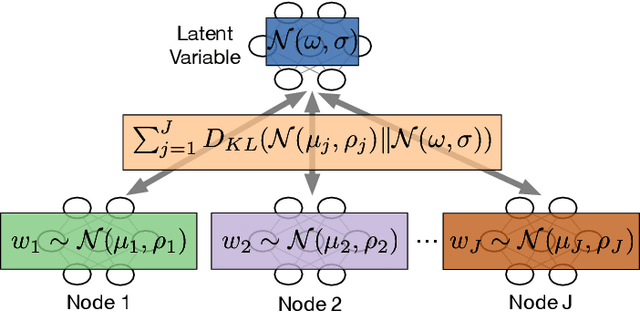

Abstract:Computed Tomography (CT) is pivotal in industrial quality control and medical diagnostics. Sparse-view CT, offering reduced ionizing radiation, faces challenges due to its under-sampled nature, leading to ill-posed reconstruction problems. Recent advancements in Implicit Neural Representations (INRs) have shown promise in addressing sparse-view CT reconstruction. Recognizing that CT often involves scanning similar subjects, we propose a novel approach to improve reconstruction quality through joint reconstruction of multiple objects using INRs. This approach can potentially leverage both the strengths of INRs and the statistical regularities across multiple objects. While current INR joint reconstruction techniques primarily focus on accelerating convergence via meta-initialization, they are not specifically tailored to enhance reconstruction quality. To address this gap, we introduce a novel INR-based Bayesian framework integrating latent variables to capture the inter-object relationships. These variables serve as a dynamic reference throughout the optimization, thereby enhancing individual reconstruction fidelity. Our extensive experiments, which assess various key factors such as reconstruction quality, resistance to overfitting, and generalizability, demonstrate significant improvements over baselines in common numerical metrics. This underscores a notable advancement in CT reconstruction methods.
Linear Combination of Saved Checkpoints Makes Consistency and Diffusion Models Better
Apr 08, 2024



Abstract:Diffusion Models (DM) and Consistency Models (CM) are two types of popular generative models with good generation quality on various tasks. When training DM and CM, intermediate weight checkpoints are not fully utilized and only the last converged checkpoint is used. In this work, we find that high-quality model weights often lie in a basin which cannot be reached by SGD but can be obtained by proper checkpoint averaging. Based on these observations, we propose LCSC, a simple but effective and efficient method to enhance the performance of DM and CM, by combining checkpoints along the training trajectory with coefficients deduced from evolutionary search. We demonstrate the value of LCSC through two use cases: $\textbf{(a) Reducing training cost.}$ With LCSC, we only need to train DM/CM with fewer number of iterations and/or lower batch sizes to obtain comparable sample quality with the fully trained model. For example, LCSC achieves considerable training speedups for CM (23$\times$ on CIFAR-10 and 15$\times$ on ImageNet-64). $\textbf{(b) Enhancing pre-trained models.}$ Assuming full training is already done, LCSC can further improve the generation quality or speed of the final converged models. For example, LCSC achieves better performance using 1 number of function evaluation (NFE) than the base model with 2 NFE on consistency distillation, and decreases the NFE of DM from 15 to 9 while maintaining the generation quality on CIFAR-10. Our code is available at https://github.com/imagination-research/LCSC.
MVHumanNet: A Large-scale Dataset of Multi-view Daily Dressing Human Captures
Dec 05, 2023
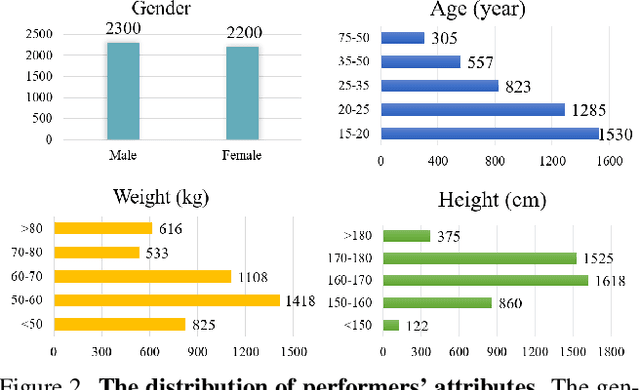
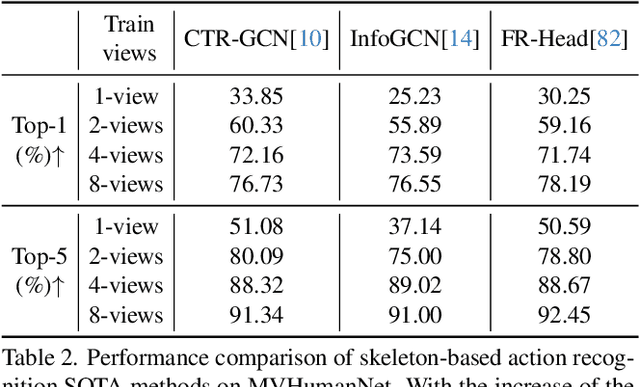

Abstract:In this era, the success of large language models and text-to-image models can be attributed to the driving force of large-scale datasets. However, in the realm of 3D vision, while remarkable progress has been made with models trained on large-scale synthetic and real-captured object data like Objaverse and MVImgNet, a similar level of progress has not been observed in the domain of human-centric tasks partially due to the lack of a large-scale human dataset. Existing datasets of high-fidelity 3D human capture continue to be mid-sized due to the significant challenges in acquiring large-scale high-quality 3D human data. To bridge this gap, we present MVHumanNet, a dataset that comprises multi-view human action sequences of 4,500 human identities. The primary focus of our work is on collecting human data that features a large number of diverse identities and everyday clothing using a multi-view human capture system, which facilitates easily scalable data collection. Our dataset contains 9,000 daily outfits, 60,000 motion sequences and 645 million frames with extensive annotations, including human masks, camera parameters, 2D and 3D keypoints, SMPL/SMPLX parameters, and corresponding textual descriptions. To explore the potential of MVHumanNet in various 2D and 3D visual tasks, we conducted pilot studies on view-consistent action recognition, human NeRF reconstruction, text-driven view-unconstrained human image generation, as well as 2D view-unconstrained human image and 3D avatar generation. Extensive experiments demonstrate the performance improvements and effective applications enabled by the scale provided by MVHumanNet. As the current largest-scale 3D human dataset, we hope that the release of MVHumanNet data with annotations will foster further innovations in the domain of 3D human-centric tasks at scale.
 Add to Chrome
Add to Chrome Add to Firefox
Add to Firefox Add to Edge
Add to Edge